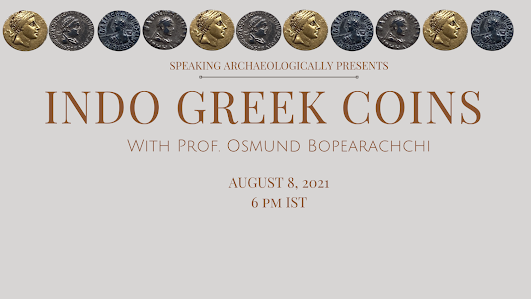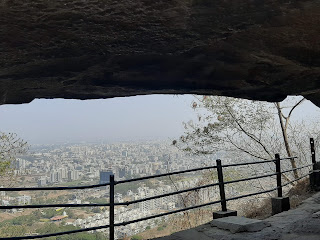The Speaking Archaeologically Workshop on Indo-Saracenic Art Revival by Tarannum Caur

Let the rooms be filled with shared beliefs
and the walls speak of a cultural blend
Let the doors open to rediscover
and preserve a forgotten heritage.
 With an aim of reviving the Indo Saracenic art form and letting it highlight one's own culture and heritage, the last Workshop of Speaking Archaeologically proved to be an opportunity for the young artists to showcase their talent. The Government Degree College at Kandaghat, district Solan, originally the palace of Maharaja of Patiala, has now been renovated. The management team has decided to let the young artists help them restore its beauty. Keeping this in view, Speaking Archaeologically organised the Indo Saracenic Revival Art Workshop on the 13th of June, 2017 at Government Museum and Art Gallery, Chandigarh, with the motive of inspiring the artists for restoration of Raja Dhaulpur House at Kandaghat, erstwhile Kohistan of Patiala.
With an aim of reviving the Indo Saracenic art form and letting it highlight one's own culture and heritage, the last Workshop of Speaking Archaeologically proved to be an opportunity for the young artists to showcase their talent. The Government Degree College at Kandaghat, district Solan, originally the palace of Maharaja of Patiala, has now been renovated. The management team has decided to let the young artists help them restore its beauty. Keeping this in view, Speaking Archaeologically organised the Indo Saracenic Revival Art Workshop on the 13th of June, 2017 at Government Museum and Art Gallery, Chandigarh, with the motive of inspiring the artists for restoration of Raja Dhaulpur House at Kandaghat, erstwhile Kohistan of Patiala.
and the walls speak of a cultural blend
Let the doors open to rediscover
and preserve a forgotten heritage.
Indo Saracenic or a blend of Indian and Persian art has left its permanence in the history of India. Be it during the period of the greatest dynasty, that is, the Mughals or after its decline, this style continued to flourish in the schools of Deccan, Rajasthan and Punjab Hills even under the British Raj. With the popularity of Miniature paintings and the European influence during the end of Akbar's reign, the detailing, realistic appearance, use of soft or bright colours and embellishments made this form of Art and Architecture stand out.
 With an aim of reviving the Indo Saracenic art form and letting it highlight one's own culture and heritage, the last Workshop of Speaking Archaeologically proved to be an opportunity for the young artists to showcase their talent. The Government Degree College at Kandaghat, district Solan, originally the palace of Maharaja of Patiala, has now been renovated. The management team has decided to let the young artists help them restore its beauty. Keeping this in view, Speaking Archaeologically organised the Indo Saracenic Revival Art Workshop on the 13th of June, 2017 at Government Museum and Art Gallery, Chandigarh, with the motive of inspiring the artists for restoration of Raja Dhaulpur House at Kandaghat, erstwhile Kohistan of Patiala.
With an aim of reviving the Indo Saracenic art form and letting it highlight one's own culture and heritage, the last Workshop of Speaking Archaeologically proved to be an opportunity for the young artists to showcase their talent. The Government Degree College at Kandaghat, district Solan, originally the palace of Maharaja of Patiala, has now been renovated. The management team has decided to let the young artists help them restore its beauty. Keeping this in view, Speaking Archaeologically organised the Indo Saracenic Revival Art Workshop on the 13th of June, 2017 at Government Museum and Art Gallery, Chandigarh, with the motive of inspiring the artists for restoration of Raja Dhaulpur House at Kandaghat, erstwhile Kohistan of Patiala.With Shriya as the Head of the workshop, Gursahiba Gill as the Information In-charge, Nimrat Dhillon as Photography and Public Dealing in-charge and I, as Project and Art Head, this workshop turned out to be a learning experience for us as well.
 The day began discussing the importance of Art history with my fellow volunteers and later, dancing to the Brazilian beats during the ride. As we reached the Museum, the sight of the Gallery and the essence of old artefacts allowed us to get back to work. The workshop was divided into two parts, the Introductory Session and the Live Art Session. The participants were taken to the Indian Miniature Paintings section where I informed them about the influence of Indo Saracenic Art form, how it started under the British Raj as a revival movement of architecture, the history of Mughals and influence of Persian art in India.
The day began discussing the importance of Art history with my fellow volunteers and later, dancing to the Brazilian beats during the ride. As we reached the Museum, the sight of the Gallery and the essence of old artefacts allowed us to get back to work. The workshop was divided into two parts, the Introductory Session and the Live Art Session. The participants were taken to the Indian Miniature Paintings section where I informed them about the influence of Indo Saracenic Art form, how it started under the British Raj as a revival movement of architecture, the history of Mughals and influence of Persian art in India.A brief account was given about the Pahari, Deccan and Rajasthan Schools of Art. Later, Gursahiba made them familiar with the culture of Punjab to let the artists use themes like festivals, costumes, Sikh culture or Punjabi folk stories as sources of inspiration. Another half an hour was spent in the gallery discussing the styles, the colours used and looking at the flemish paintings. The Punjabi paintings of the late 19th century were loved by most of the artists.
After the orientation, the live art session commenced. The artists were asked to draw elements from Indian and Persian art and use them to portray the culture of medieval India and Punjab. The session witnessed delightful performances of the artists.
After the end of the workshop, the following hour was spent enjoying the Subway meals, talking to the familiar and the unfamiliar voices and pondering upon the magic that the artists will add to the walls of a restored building. With colour palettes in one hand, and painting tools in the other, they will let history echo in the murals.




Comments
Post a Comment